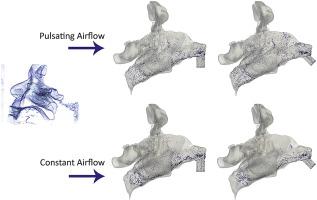Computers in Biology and Medicine ( IF 7.0 ) Pub Date : 2020-05-18 , DOI: 10.1016/j.compbiomed.2020.103816 Ali Farnoud 1 , Ingo Baumann 2 , Mohammad Mehdi Rashidi 3 , Otmar Schmid 4 , Eva Gutheil 5

|
Numerical simulations of the dispersion and deposition of poly-disperse particles in a patient-specific human nasal configuration are performed. Computed tomography (CT) images are used to create a realistic configuration of the nasal cavity and paranasal sinuses. The OpenFOAM software is used to perform unsteady Large Eddy Simulations (LES) with the dynamic sub-grid scale Smagorinsky model. For the numerical analysis of the particle motion, a Lagrangian particle tracking method is implemented. Two different nosepieces with clockwise inclinations of 45° and 90° with respect to the horizontal axis are connected to the nostrils. A sinusoidal pulsating airflow profile with a frequency of 45 Hz is imposed on the airflow which carries the particles. Flow partition analysis inside the sinuses show that ventilation of the sinuses is improved slightly when the 45° nosepiece is used instead of the 90° nosepiece. The flow partition into the right maxillary is improved from 0.22% to 0.25%. It is observed that a closed soft palate increases the aerosol deposition efficiency (DE) in the nasal cavity as compared to an open soft palate condition. The utilization of pulsating inflow leads to more uniform deposition pattern in the nasal airway and enhances the DE by 160% and 44.6%, respectively, for the cases with clockwise 45° and 90° nosepieces, respectively. The bi-directional pulsating drug delivery with the same particle size distribution and inflow rates as the PARI SINUS device results in higher total DEs with 45° nosepiece than with the 90°. Thus, the numerical simulation suggests that the 45° nosepiece is favorable in terms of the delivered dose.
中文翻译:

使用顺时针45°和90°鼻架模拟患者特定的双向脉动鼻气溶胶分散和沉积。
对患者特定的人鼻配置中的多分散颗粒的分散和沉积进行了数值模拟。计算机断层扫描(CT)图像用于创建鼻腔和鼻旁窦的真实配置。OpenFOAM软件用于通过动态子网格比例Smagorinsky模型执行不稳定的大涡模拟(LES)。为了对粒子运动进行数值分析,采用了拉格朗日粒子跟踪方法。相对于水平轴具有45°和90°顺时针倾斜度的两个不同的镜脚件连接到鼻孔。在携带颗粒的气流上施加频率为45 Hz的正弦脉动气流轮廓。鼻窦内部的流量分配分析表明,当使用45°鼻架代替90°鼻架时,鼻窦的通风会略有改善。流入右上颌的流量分配从0.22%提高到0.25%。观察到与开放的软pa相比,封闭的软pa增加了鼻腔中的气溶胶沉积效率(DE)。对于分别具有顺时针旋转45°和90°鼻梁的情况,利用脉动流入可导致鼻气道中的沉积模式更加均匀,并将DE分别提高160%和44.6%。与PARI SINUS设备具有相同的粒径分布和流入速率的双向脉动药物输送,与90°相比,在45°鼻架上产生的总DE更高。从而,











































 京公网安备 11010802027423号
京公网安备 11010802027423号